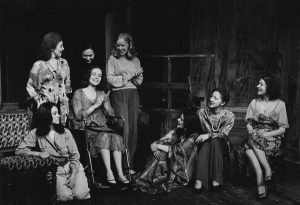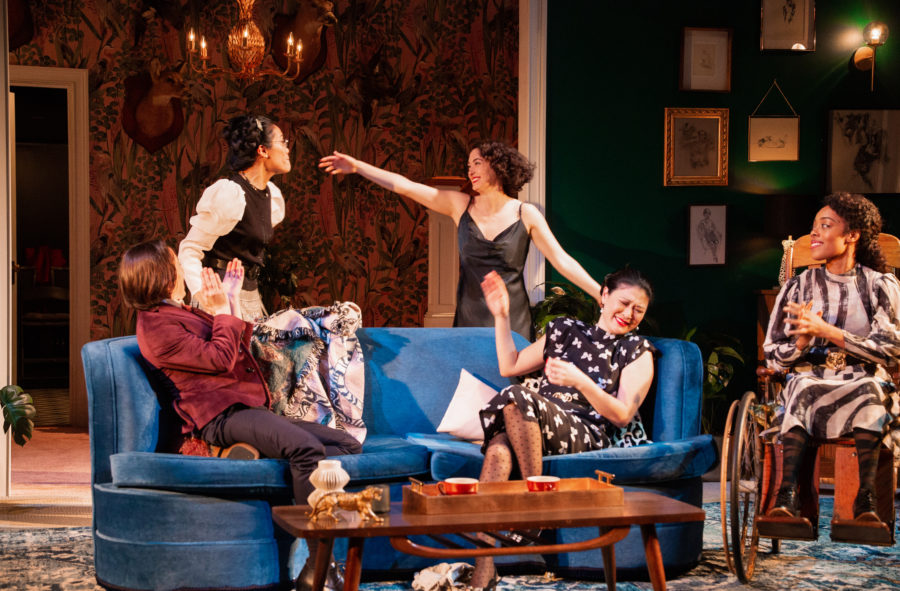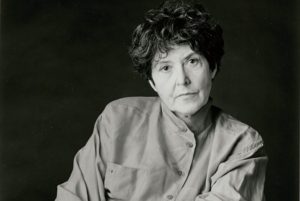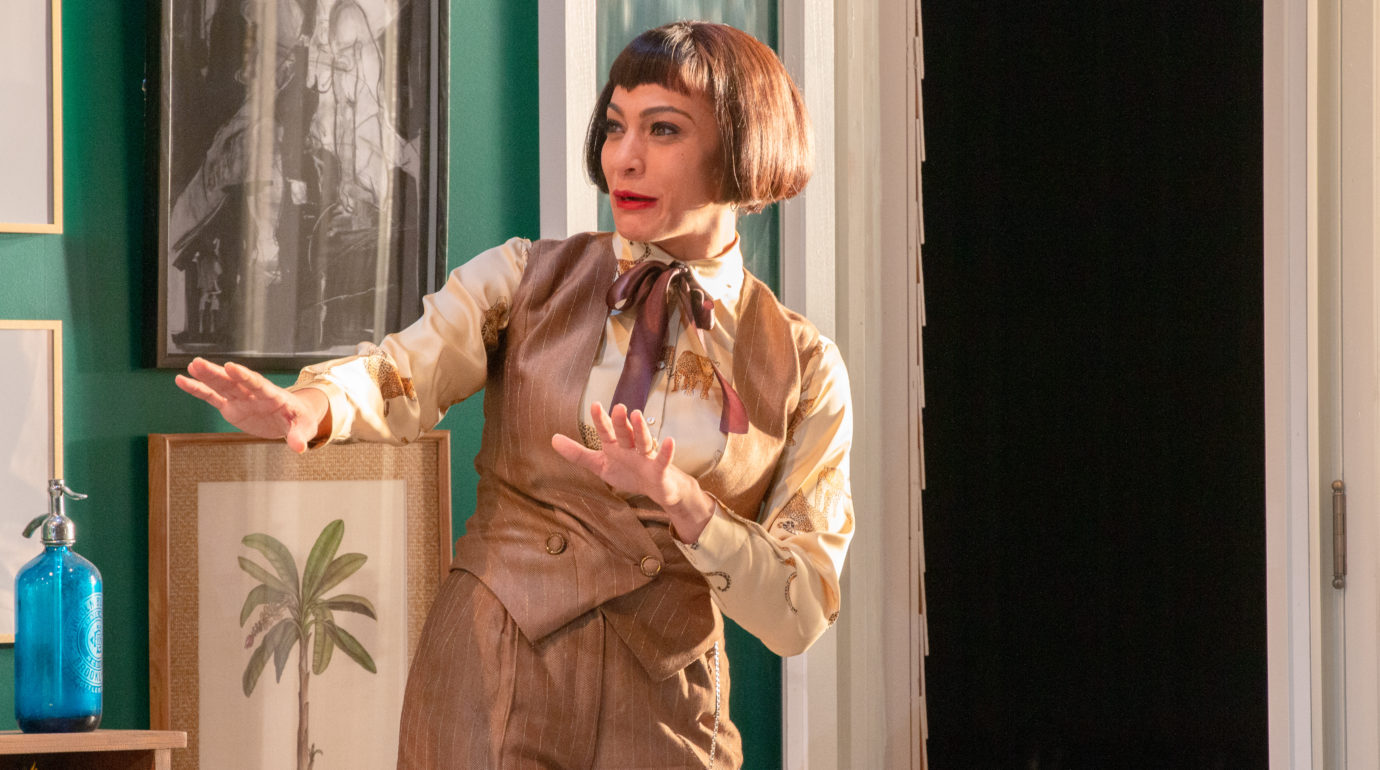At the end of 2019, Theatre for a New Audience produced a welcome revival of Fefu and Her Friends by María Irene Fornés. I had no way of knowing at the time that it would be the last production I’d see before live performances were shut down in New York City because of the COVID-19 pandemic. During the long year that followed I kept the memory of that production with me as I continued to write plays in a battered New York City. Fefu and Her Friends, and Fornés’s voice, became a kind of interlocuter that I used to help me think through our renewed attention to some old debates: debates over the relationship between, on the one hand, making art and, on the other, the indispensable work of making the world a better place.
Fefu and Her Friends was first staged almost five decades ago, in 1977, during a similarly tumultuous time in our country’s history. In the play’s woolliness we recognize affinity with the ethos of that long-ago year, in particular the spirit of second-wave feminism then still enjoying the afterglow of the giddy heyday it experienced in the late ’60s and early ’70s. That was an irrepressible period that spawned works as disparate as Jill Johnston’s Lesbian Nation, Valerie Solanas’s SCUM Manifesto, and Germaine Greer’s The Female Eunuch. I wonder if we can avoid parsing all the ways these seminal feminist works are incompatible with the political standards of our present, and instead appreciate them as part of the fecund ecology from which they sprung and which they, in turn, helped to sustain. What those feminist works have in common is their willingness to follow an uncompromising idea and pursue it fully, then inspire a community of readers to use those ideas as cornerstones upon which to build unconventional lives. By invoking the year the play was staged I wish to summon the same ethos Fefu invokes when she says she likes exciting ideas because they give her energy.

Fornés’s play is ostensibly about eight women who gather at a country house in 1935 to plan a fundraising event in furtherance of a social reform project focused on education and the arts. But the play doesn’t so much tell us this as create the living, breathing experience of eight female friends who delight in each other’s company and come together to collaborate. The immersion into this country house happens most vibrantly in the second act of the play—the script calls its acts “parts”—during which the audience is divided into four groups, each of which moves, one by one, through four rooms (the garden, an improvised bedroom, the kitchen and the study) to eavesdrop at close quarters on four different scenes, which we understand are happening simultaneously in the house.
The sequence in which we experience the scenes is not important; the pleasure is watching the way Fornés takes a few minutes of time and slows it down, viewing it again and again from multiple angles as if it were a cubist painting. Two friends in the garden try to describe the bonds that link them and we watch as they fail to find adequate words. When one of them is eventually left alone, she resorts to building a doll in the image of her friend (in the script, though not in the production at Theatre for a New Audience) so she can recite a sonnet by Shakespeare to this improvised surrogate. While this odd, elliptical scene is happening, we overhear a muffled conversation taking place in the kitchen. Later we will sit in that kitchen and watch two ex-lovers try to make sense of who they are to each other now, and we will be reminded that on the other side of that wall, out in the garden, another pair of women are trying to make sense of their own very different relationship.
Fornés’s great achievement is that she recreates not a story exactly (though there is one), not a series of events in a plot (though there are plenty), but the emotional charge one feels in a house crowded with friends. If this act feels woolly and irrepressible and impossible to contain in just one room, it is because the friendship and history these women share is woolly and irrepressible and impossible to contain in just one room.
I am indebted to the cultural critic Ann Pellegrini, who used the adjective woolly to describe (and delight in) the early days of second-wave feminism. I interpret Pellegrini’s use of the word woolly as her way of capturing the era’s wildness, and her celebrating the courage it takes to disrupt. But I also hear in the word a recognition of the virtue of painting with rough lines, the value of honoring something that is nascent. The unfinished is the place we most clearly discern the pulse of potential, and that is why social movements, like works of art, are often in closest touch with the values that sparked them when they are beginning. A play that divides its audience into four groups and makes each of them simultaneously see a different middle act is a play that is trying to avoid the ossification that haunts everything that is finished.
❦
Can a political movement stay true to its values after it is institutionalized? No, it can’t. Can a work of art stay true to the impulse that sparked it? A good one can, yes. That is one of the differences between politics and aesthetics.
❦
Given the play’s affinity with the ethos of the year it was written, it’s worth considering why Fornés chose to set it in the 1930s. The playwright Andrea Thome suggests that the gesture is an homage to what she playfully refers to as “women’s pict-chahs”—those films from the ’30s and ’40s, directed by the likes of George Cukor and Preston Sturges, but really made by actors like Joan Crawford and Bette Davis. Films centered on female protagonists whose lives were shaped by their own unconventional choices, choices these tough protagonists had to defend with their wit, sure, but mostly their will. It’s not hard to see how a young lesbian like Fornés might have found in those films evidence that a savvy enough iconoclast might be able to push the existing social order just enough to give her some room to maneuver. The homage to these films was made explicit in the Theatre for a New Audience production by the dapper, period-inflicted costumes of Montana Levi Blanco (the costumes were the first thing I heard people mention about the production before I saw it).
But I see in Fornés’s decision to set the play in the ’30s evidence also of her restlessness. She was never a writer satisfied with living within the familiar confines of the here and now—her plays are frequently set in locations and eras outside of her own biographic experience, and frequently about characters ostensibly quite different from her. She wrote plays set in Budapest, 19th-century London, an unspecified location reminiscent to some of Appalachia. (The unspecified location was one of her long-standing strategies; Fornés was not one to be tied down.) And while she is often, rightly, praised for the richness of her female characters, and their stubborn pursuit of their aspirations, anyone reading Conduct of Life or Mud will be struck with the precision with which Fornés plumbed the depths of her male character’s psyches.

This cosmopolitanism—in terms of temporality, geography, and identity—stands in contrast to the recent retreat into the notion that artists should not stray too far from their own lived experience. Brooklyn-based artist Charlie Mai calls this policing of authenticity the stay-in-your-lane dimension of identity politics. We are of late too often troubled when curious artists chafe against the guardrails of the more reductive versions of identity politics. Fornés’s capacity for empathy and her restless thirst to escape the confines of the here and now are not shortcomings or remnants of a less-informed era; they are preconditions to writing.
❦
It feels strange to refer to her as Fornés. That is not what I called her in person. I certainly never called her Irene, not to her face—that would have felt glib and in insufficient recognition of her influence on me (and an entire generation’s worth of Latino playwrights). But I am not going to share here what I called her because too many of you would not understand the Spanish word I used, simultaneously a title of respect and a term of affection. (The Gustavo Pérez Firmat poem said it well: “Writing to you / in English / already falsifies.”)
Most of us who got a chance to study with her (and by “us” I mean most Latino playwrights I know) can mark a clean line in our work as writers: how we worked before we were introduced to Fornés’s pedagogy, and everything that came after. That line is roughly equivalent to the difference between faking it and actually writing. After learning from Fornés, we could not face ourselves unless we endeavored to write plays that lived (and breathed) on their own terms. Every play, she insisted, had to be its own compass. Suddenly there was no model or form that could guide us; nothing that predated the impulse behind our play would be of any use to us. To have studied with Fornés is to have been terribly inconvenienced.
I have colleagues who, though they did not get to study with Fornés, have described being influenced by her style: the precise sentences of her mature plays, the open sincerity of her characters, or the way she stretches form. But this kind of imitation is merely stylistic, and Fornés turned her nose up at it as missing the point. Fornés the teacher, and even Fornés the theatregoer, was not interested in any particular style; indeed, that her students shared no common style was something she boasted about. She worked to impart an ethos of writing, and by extension, an approach to living.
❦
In the canon of plays by María Irene Fornés, each a cause for a standing ovation, Fefu and Her Friends is a transitional work. The play seems poised between the maximalism of the musical Promenade and crystalline masterworks like The Danube and Mud that Fornés would write just a few years later. It’s odd, given the play’s unsettled form, that it might be the script of hers that is most often taught in this country’s theatre programs. Certainly the audience at the Theatre for a New Audience production contained a higher number than usual of young faces, recent college graduates wanting, I suspect, some confirmation of what all the fuss is about. (Our theatre audiences are nothing if not deferential to experts.) But arguments on the script’s behalf that stress its importance—essentially admonishments to show some respect—turn ticket buyers into schoolchildren. Might we instead revel in the presence of Fornés’s sensibility, especially her sense of play?
Fefu and Her Friends is a script full of deep feeling, but it also makes room again and again for impish jokes and games. The jokes are not particularly funny, the games disarmingly simple. The character named Sue, for example, runs through a series of implausible explanations for why she has discovered in the freezer ice cubes that have each been made with a toothpick sticking up at their center. If the toothpicks are meant to be handles, perhaps, she hypothesizes, they are brain coolers that can be held against one’s temples? Weapons used during Eskimo wrestling? Tiny spears to repel kisses when the ice cube is held in the mouth? The actor Ronete Levenson delivered these guesses with charming understatement; we enjoyed watching her enjoy herself. Levenson smiled as she tossed off the guesses, similar to the way an actor improvises possibilities for a new line. The not-quite-funny jokes are—like Emma building a doll out of root vegetables, or the uproarious water fight in the third act—evidence of the characters at play.

Years ago, when Fornés’s friends were first beginning to exchange whispers about her deteriorating memory, she came to see a workshop of a play of mine at the old Intar Theatre on West 53rd Street (a theatre which was the site of the Hispanic Playwrights Lab that Fornés ran for 14 years, and which has since been demolished and replaced by condominiums none of those participating playwrights can afford). A group of us went out for drinks afterwards. I remember that José Esteban Muñoz was with us, I remember the indomitable Migdalia Cruz adjusting her lipstick, and most of all I remember a tipsy Fornés leaning in and asking me if I had played with dolls when I was a child. No, I told her, I hadn’t. She pulled back with surprise. With genuine incredulity she asked, “Then how did you ever come to write plays?”
I don’t think an artist has ever so succinctly described her own process. When Fornés sat down to write, there was a level at which she was playing with dolls. (The dolls might masturbate onstage, torture, or murder, but please don’t make assumptions about content based on a playwright’s process.) We cannot understand Fornés’s oeuvre without connecting to this foundational sense of joy. Any of the tragic endings Fornés wrote begin here, in this spirit of play.
Fornés took pleasure in writing and encouraged her students to do the same. But there is a greater benefit here than the pleasure of authors: There can be no creativity without play—and without creativity we will never generate alternatives to the status quo.
❦
Fornés once told me that people who want to write political plays should first live political lives. Only then should one sit down to write and see if what you write comes out as a play and if it comes out as political. (For Fornés, everything hinges on the word if.) Perhaps, Fornés mused, after living a political life the play one then wrote might turn out to be political after all—but one shouldn’t be surprised if the politics of the play differed from the politics of the writer. What might appear as a whimsical musing is actually evidence of how seriously Fornés took politics and how seriously she took theatre.
❦
Do politics and aesthetics have anything in common? They do. One thing they have in common is that neither can be of any use to us if they do not involve risk.
❦
I invoked the emancipatory afterglow of second-wave feminism not to engage with the content of Fornes’s play but instead to invoke its spirit. That spirit can be experienced most vibrantly in the aesthetic realm, not the political realm.
I know our current political crises means there are those who will misunderstand what I am saying. Let me be clear: Aesthetics can never be an alternative to, nor an escape from, politics. They cannot be, because for many of us wading into the fray of politics is necessary if we want to survive.
But when we filter the expanse of the aesthetic realm through the narrow funnel of our politics we lose something worth preserving. Others would note, for example, that Fefu and Her Friends eschews a central protagonist and instead asks us to identify with a collective. One could call attention to the penchant these female characters have for total frankness, with each other and with themselves, and be reminded that that level of self-awareness was the method and the goal of feminist consciousness-raising groups. One could point out the way the characters demonstrate again and again mutual care for each other. These readings are productive but they leave out too much.
In contrast, Fornés’s body of work shows us how to make art that is attuned to the politics of the moment but keeps its aspirations fixed beyond the present. Indeed the famous first line of the play—“My husband married me to have a constant reminder of how loathsome women are”—can be read as a shot across the bow of anyone who puts too much faith in political programs. That feminist affirmations might be indispensable to survival doesn’t mean they are sufficient to satisfy the appetite of someone like Fefu. In the play’s opening line, she insists on more. That she may not yet know what else she is insisting on does not disqualify her demand; it makes Fefu bolder.
What happens if we sit down to watch a Fornés play with the idea that the aesthetic realm might have something to teach our politics, and not the other way around? What happens if we turn the prevailing ethos of our current moment—that art should live up to our politics—on its head, and instead insist that it is our politics that must live up to our art? Politics, after all, must always hone, which is to say reduce. But Fornés’s play wants to multiply. Our politics strain towards a finish line, but Fornés’s play wants to linger. Politics compels us to address the emergencies of today, Fornés’s play invites us to travel to decades long past.
Fornés has placed eight female characters onstage and has asked them to capture the ineffable delicacy of their friendship. As we watch the resulting play, will we be still enough to recognize that we are in the presence of yearning? If we learn to listen to that yearning closely enough, if we follow it faithfully enough, then it can become a kind of compass. And if we follow such a curious compass, who knows how much further our horizons might expand?
Jorge Ignacio Cortiñas (he/him) is an American playwright and director who lives in New York City. Before pivoting to making theatre, he worked for years as an organizer in furtherance of immigrant rights, access to healthcare, and human rights. His plays include Blind Mouth Singing, Bird in the Hand, and Recent Alien Abductions.


